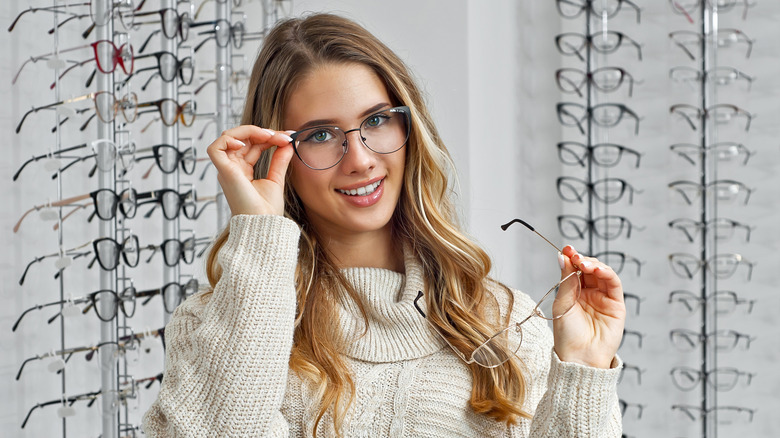Signs You May Need Glasses
If you think you may need glasses, you're in good company. Reference estimates that the number of adults worldwide who wear glasses exceeds four billion. According to The Vision Council, 166 million adults in the United States wear prescription eyeglasses, with 34.5 million wearing over-the-counter glasses for reading.
Correcting your vision can have a notable impact on your daily life. You'll find it easier to perform tasks requiring eyesight, and you'll likely experience the increased enjoyment that accompanies better vision and fewer symptoms like eye strain, nausea, and dizziness. There may even be cognitive benefits to vision correction, according to a 2018 study published in JAMA Ophthalmology: Maintaining clear vision may help to stave off cognitive decline caused by fading eyesight in older people.
The Mayo Clinic notes that eye exams may enable you to address vision problems in their early stages when they're easier to treat. If you are in good health with no symptoms of vision problems, it's recommended that you have a complete eye exam at 40 years of age, when age-related vision changes may start to occur. However, you don't have to wait until then if you're experiencing any of the signs that you may need glasses.
Objects far away look blurry
Clear vision occurs when the light rays entering your eyes meet at a focal point on your retina, a layer of light-sensitive tissue at the back of each eye (via MedlinePlus). Nearsightedness, or myopia, is a condition in which this focal point exists in front of your retina rather than on it, causing blurred distance vision (via Mayo Clinic). According to MedlinePlus, this type of refractive error happens when the eyes are longer than they should be, and the rays of light bend toward each other too soon. Myopia can also occur when your cornea, the transparent front cover of the eye, is too steep.
There are several reasons for blurry vision, and finding the cause of yours can lead to effective treatment. Blurred distance vision is only one of several myopia symptoms. Others include squinting, headaches, and difficulty seeing while driving. If symptoms like these interfere with your usual activities, it's time to see a trained practitioner who can diagnose myopia with a standard eye exam.
The Mayo Clinic offers three suggestions for treating myopia: eyeglasses, contact lenses, or surgery. Eyeglasses for the treatment of myopia have concave lenses. Concave means curving outward, to widen the light entering through the cornea. This type of eyeglass lens moves your focal point further back in your eye so that it lands directly on the retina, bringing your distance visual acuity into focus.
Objects close to you are blurry
Hyperopia (farsightedness) is another type of refractive error that you can treat with glasses. If you live with hyperopia, your eye length is too short, causing your visual focal point to occur behind your retina. According to MedlinePlus, glasses with convex lenses narrow the plane of light entering the eye so the focal point moves forward to the retina. This allows you to clearly see objects that are close.
Hyperopia is less common than myopia and is seen in about 10% of Americans age 40 and over, according to the American Academy of Ophthalmology (AAO) – though it is also seen in children. The majority of full-term infants have a mild case of hyperopia, and at 12 months of age, the prevalence drops to about 3.6%.
The most common symptoms of hyperopia are blurred vision and squinting while trying to see at near distances. Without glasses, you may have trouble reading or using a device such as a cell phone or TV remote. Eye strain, headaches, and eye pain are also signs. You may also experience binocular vision dysfunction (BVD), which means that both eyes are unable to coordinate properly.
Your vision is distorted
The AAO describes astigmatism as an imperfection in the shape of your cornea or lens. Rather than having a round curvature, an eye with astigmatism is oval. If the oval is positioned horizontally, it's referred to as with-the-rule astigmatism. If the oval is in a vertical position, it's called against-the-rule astigmatism. As in the case of myopia and hyperopia, this misshape causes refractive errors that can impact your vision.
Astigmatism causes symptoms that are similar to other eye conditions, so it's important to see an eye doctor for a proper diagnosis. Common symptoms may include blurry or distorted vision, headaches, eye discomfort, and the need to squint.
Eyeglasses usually work well for mild to moderate astigmatism. Other corrective measures you can take include contact lenses and surgery. According to Healthline, some people with astigmatism can still have 20/20 vision and don't need glasses. However, the condition can worsen with time, and regular checkups can catch changes as they happen. If you start to experience signs like double vision and trouble seeing at night, it may be an indication that you need glasses.
You're finding it harder to focus on nearby objects as you age
The Mayo Clinic describes presbyopia as a natural part of aging. You may first notice the telltale loss of ability to focus on close objects when you're in your mid-40s. A key sign is the need to hold something like a book or your phone at arm's length to see it. This primary presbyopia symptom worsens until you're around 65 years of age. Presbyopia is common, with The Lancet estimating its global prevalence at about 1.1 billion people as of 2018.
The lens of the human eye is partially flexible, which allows it to change shape to help focus your vision (via Mayo Clinic). A muscle surrounding the lens relaxes or constricts to change the lens curve as needed. As you age, the lenses in your eyes harden and become less flexible, making it increasingly difficult for them to change shape. As a result, you may not be able to see close objects as clearly as you could when you were younger.
Presbyopia is usually correctable with glasses. You may not even need prescription lenses, as over-the-counter reading glasses work for many people. If over-the-counter glasses aren't sufficient, there's a range of prescription options available including reading glasses, bifocals, trifocals, and progressives.
You're losing central vision and straight lines appear wavy
The loss of central vision (i.e. having a hard time seeing things straight in front of you) and seeing straight lines that look wavy are symptoms of age-related macular degeneration (AMD). Aging can sometimes damage the macula, which is the part of your retina responsible for straight-ahead vision. Developing AMD can interfere with your ability to perform tasks that use your central vision, like reading, driving, and recognizing faces. AMD is a very common cause of vision loss in older adults: The National Eye Institute estimates that in the United States, around 11 million people have this condition.
According to Healthline, AMD occurs as one of two types: dry or wet. Dry AMD can become wet AMD at any stage. Dry AMD progresses slowly and is more common than wet AMD, which can develop rapidly and lead to more severe vision loss. In dry AMD, fat and protein build up under your macula and interfere with your vision. Wet AMD features irregular blood vessels that occur under the macula that can leak fluid into the retina.
Wet AMD is treatable with injections or lasers to reduce the growth of irregular blood vessels in your eyes. There is no treatment for dry AMD, but you can slow its progression with dietary changes, such as consuming nutrient-dense foods like leafy greens, vegetables, and fish. Eyeglasses can't reverse the vision loss from AMD, but magnifiers can help with reading, and UV-protective sunglasses can prevent the condition from worsening.
You're experiencing double vision
Strabismus is a condition featuring eye muscle imbalance that results in crossed eyes or eyes that point in different directions. The AAO states that eye movement depends on six muscles that must work together. Strabismus can result from an issue with the muscles themselves, or with the area of the brain that controls them. Strabismus usually starts in childhood, but it can also develop later in life from issues like stroke or head injury.
Our eyes are designed to focus on the same spot so the brain can use the combined information from both eyes to construct a three-dimensional image. Strabismus causes the eyes to be out of alignment so that two different images are sent to the brain. When a young child has strabismus, the brain stops communicating with one eye and ignores its image. However, if you develop strabismus as an adult after your brain has learned to respond to both eyes, the strabismus eye misalignment can cause double vision.
According to the American Association for Pediatric Ophthalmology and Strabismus (AAPOS), prismatic glasses are a treatment option. Other treatments include specialized eye exercises and surgery. Any of these treatments can correct the double vision that is a symptom of this condition.
Colors look faded
The National Eye Institute estimates that more than half of U.S. adults 80 years of age or older have cataracts or cloudy regions in the lens of the eye. Cataracts form when aging or health issues cause fibers and proteins in your lenses to break down and clump together (via Mayo Clinic). Initially there may be no symptoms, but in time you can experience blurred or hazy vision, difficulty reading, and faded colors. The cause of cataracts is usually aging, although you can develop them after surgery for a different eye condition or after an injury to the eye (via National Eye Institute).
Surgery is the primary treatment for cataracts. In the early stages, you can manage cataract-related vision changes using stronger lighting and eyeglasses. If your condition progresses to the point where seeing a surgeon is the best option, it's reassuring to know that cataract surgery is generally effective and safe.
Your lifestyle can influence whether you develop cataracts. Smoking, obesity, high blood pressure, and excessive sunlight exposure are all factors that can contribute, according to the Mayo Clinic. Health conditions like diabetes can also increase your risk.
You see rainbow halos around lights
Your optic nerve is key for healthy vision. The optic nerve is the reason that the signals captured by your retina can become images in your brain. If you see halos in rainbow colors around lights, your optic nerve may be sustaining damage from a condition called glaucoma. According to the Cleveland Clinic, glaucoma is second only to cataracts as a leading cause of blindness and affects around 3 million people in the United States.
Increasing intraocular pressure from fluid accumulation is the cause of optic nerve damage in glaucoma. There are several different types. The most common is open-angle glaucoma, in which your eye drainage canals are blocked by the buildup of small deposits. Closed-angle glaucoma occurs when the space is too narrow between the iris of your eye and the cornea, resulting in elevated eye pressure. Normal-tension glaucoma causes optic nerve damage even without increased pressure. Congenital glaucoma is the result of eye drainage canals that are improperly formed at birth.
Catching glaucoma in its early stages can improve the outcome, so regular glaucoma tests are advised for those who are at high risk or over the age of 40. Treatment options include eye drops, laser treatment, and surgery. The Glaucoma Research Foundation also indicates prism eyeglasses that widen the field of vision may be a helpful tool in treating this condition.
You experience regular headaches
Tension headaches have several different causes, one of which is eye strain. If you experience regular headaches, the reason might be an uncorrected vision issue. Healthline explains that the increased work required to form a clear image when you have uncorrected vision can cause a tension headache. If you already wear glasses or contact lenses and still get eye strain headaches, you may need to update your prescription.
Lumen Optometric explains that untreated farsightedness can cause a type of headache called a brow ache that occurs at the front of your head, due to the strain of trying to focus harder on objects that are close. The age-related eye condition presbyopia can also cause headaches (via Mayo Clinic).
Headaches are common and often not serious. If your headaches are the result of a vision issue, visiting your eye doctor for a diagnosis and eyeglasses prescription may help. However, certain types of headaches may not be related to your vision and may require immediate medical attention. Cedars Sinai recommends that you see a doctor right away if your headache is worse than any you've previously had, you experience vomiting you can't control, you lose consciousness or your vision, or if the headache persists for longer than 72 hours.
You experience dizziness
According to Medical News Today, your ability to balance is the result of three systems that work together: the vestibular system (involving your inner ear), the visual system (relating to your eyes), and the proprioceptive system (sensory information from muscles and joints). If one of these balance contributors isn't working quite right, you may experience dizziness as a result.
Binocular vision problems are a common cause of vision-related dizziness. Binocular vision refers to the way your eyes work together to focus on a single point. Misalignment of your eyes that disrupts binocular vision can cause eye strain that leads to dizziness.
Your vision also helps to calibrate a part of your vestibular system called the vestibular-ocular reflex (VOR). An article from Eye Brain explains the way in which normal VOR function makes it possible for you to carry out tasks like driving a car or walking. VOR disruption can cause symptoms like dizziness, balancing problems, and even nausea. Vestibular Disorders Association (VEDA) recommends that people with VOR dysfunction switch from lenses like bifocals and trifocals to multiple pairs of single-vision glasses to reduce the extra work required switching between levels of magnification. They also recommend ensuring that your glasses are properly fitted.
You regularly feel nauseated
Nausea is a symptom of so many conditions, and eye muscle strain is one of them. The Vision Specialists of Michigan explain that there are two forms of binocular vision dysfunction (BVD) that can cause nausea. One is known as Superior Oblique Palsy (SOP) and the other is called Vertical Heterophoria (VH). These conditions cause one eye to move out of alignment with the other, thereby changing the vertical position of the images you see. Eye strain leading to fatigue and then nausea results as your brain tries to force your eyes back into alignment.
The Optometrists Network recommends a combination of prismatic lenses and vision therapy to treat BVD. Prismatic lenses work like other types of glasses in that they change the way that light enters your eyes. Rather than moving the focal point, as for conditions like myopia and hyperopia, prismatic lenses change the incoming image in such a way that your brain thinks the input from both eyes is properly aligned. Your brain is then able to combine this input into one image.
You find yourself squinting
Most people squint at some time or another, such as to protect their eyes against the glare from the sun. However, if you find yourself regularly narrowing your eyes in an effort to see better, it may be a sign that you need glasses. Squinting is a symptom of several refractive error eye conditions, like myopia, hyperopia, and presbyopia.
Eye care physicians Grosinger, Spigelman & Grey explain how squinting helps you see better. Squinting can change the shape of your lens, which can adjust the way it focuses. In addition, squinting reduces the amount of light that enters your eye, which can cause the object you're looking at to appear more in focus.
While some squinting is normal, if yours accompanies other vision-related symptoms like double vision, problems reading, difficulty driving at night, and headaches, it may be time to schedule an eye exam to see whether glasses could reduce your symptoms and improve your vision.













